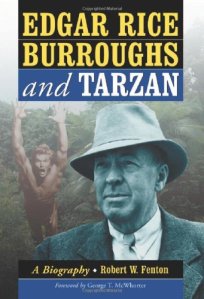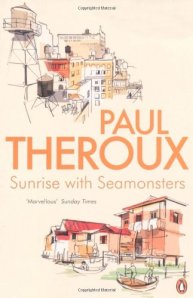 March
19
March
19
Tags
Tarzan and the Story of White Settlers in Africa
 On the 19th of March 1950, the American writer widely known for his creation of the jungle hero Tarzan, Edgar Rice Burroughs, died in Enciano, California. After doing various low paid jobs, first at a ranch in Idaho, then at his father’s firm, and later as a pencil sharpener wholesaler, he did not take up writing until his late thirties. His inspiration came from reading pulp fiction magazines, which gave him the impression that he could write much better than most of the authors published in them at the time. He said that, “…if people were paid for writing rot such as I read in some of those magazines, that I could write stories just as rotten. As a matter of fact, although I had never written a story, I knew absolutely that I could write stories just as entertaining and probably a whole lot more so than any I chanced to read in those magazines.” (Edgar Rice Burroughs, How I Wrote the Tarzan Stories, The Washington Post, The New York World (Sunday Suplement), October 27, 1929). And so in 1912, Burroughs’ first story, Under the Moons of Mars, marked the beginning of a very prolific writing career. The story was soon made into a series in The All-Story pulp fiction magazine, and shortly afterwards the jungle hero Tarzan was born. Tarzan of the Apes was first introduced as a series in a pulp magazine at the end of 1912, and in 1914 was published as a book. Several more books, comic strips and movies followed, turning Tarzan into a worldwide phenomenon.
On the 19th of March 1950, the American writer widely known for his creation of the jungle hero Tarzan, Edgar Rice Burroughs, died in Enciano, California. After doing various low paid jobs, first at a ranch in Idaho, then at his father’s firm, and later as a pencil sharpener wholesaler, he did not take up writing until his late thirties. His inspiration came from reading pulp fiction magazines, which gave him the impression that he could write much better than most of the authors published in them at the time. He said that, “…if people were paid for writing rot such as I read in some of those magazines, that I could write stories just as rotten. As a matter of fact, although I had never written a story, I knew absolutely that I could write stories just as entertaining and probably a whole lot more so than any I chanced to read in those magazines.” (Edgar Rice Burroughs, How I Wrote the Tarzan Stories, The Washington Post, The New York World (Sunday Suplement), October 27, 1929). And so in 1912, Burroughs’ first story, Under the Moons of Mars, marked the beginning of a very prolific writing career. The story was soon made into a series in The All-Story pulp fiction magazine, and shortly afterwards the jungle hero Tarzan was born. Tarzan of the Apes was first introduced as a series in a pulp magazine at the end of 1912, and in 1914 was published as a book. Several more books, comic strips and movies followed, turning Tarzan into a worldwide phenomenon.
The story of a British boy adopted by a tribe of apes appealed to the imagination of millions of readers all over the globe. However, due to his individual characteristics, the noble savage of Caucasian origin, extremely strong and handsome, brave and intelligent, impersonating the best kind of heroism, became especially appreciated by the white population. He became their ultimate hero, representing a certain aspirational dream. But what kind of dream was it? Paul Theroux in his book Sunrise with Seamonsters: Travels And Discoveries 1964-1984 recalls his childhood infatuation with Tarzan: “The Tarzan I remember was a strong white man in a leather loincloth, always barefoot; and he was handsome, a wise mesomorph, powerful, gentle, and humorless. The animals all knew him. He spoke to them cryptically, in a sort of private Kitchen Swahili (two of the words he frequently used were bundolo and tarmangani). The animals replied in bubbles that only Tarzan understood. Although he was known as Tarzan, “The Ape-Man,” he was undeniably a man and bore not the slightest trace of simian genes.” Further on, Theroux starts looking at Tarzan from a more critical perspective, analysing his real position and meaning within the jungle context. He notices that, “In spite of the fact that there was a green parrot with his claws dug into Tarzan’s shoulder, a monkey holding his hand, and a lion faithfully dogging his tracks, Tarzan did not admit these creatures to his definition . In the most politic way, by not mentioning them, he excluded the animals from the society of the intimate white three. There was no question of equality: the fact remained that the animals simply were not the same and could therefore never have the same rights as the humans. Tarzan did not aggravate the situation; he asserted his authority over the animals very passively…Yes, of course he swung on vines, beat his chest, and roared convincingly, but these gestures were not an expression of thorough animalism as much as they were the signal of a certain solidarity with the animals; as gestures they demonstrated futility as well as sympathy, and it was this sympathy that made them seem genuine.”
. In the most politic way, by not mentioning them, he excluded the animals from the society of the intimate white three. There was no question of equality: the fact remained that the animals simply were not the same and could therefore never have the same rights as the humans. Tarzan did not aggravate the situation; he asserted his authority over the animals very passively…Yes, of course he swung on vines, beat his chest, and roared convincingly, but these gestures were not an expression of thorough animalism as much as they were the signal of a certain solidarity with the animals; as gestures they demonstrated futility as well as sympathy, and it was this sympathy that made them seem genuine.”
Theroux uses this critique not so much for the purpose of literary analysis of the jungle hero per se, but rather in order to visualise a much bigger social phenomenon that occurred at the end of the nineteenth and the beginning of the twentieth century – he refers to the period of white settlers in Africa, whom he calls here ‘expatriates.’ And so the expatriates, according to Theroux, have much in common with our literary hero, living their dream lives as ‘Kings of the jungle’, with a highly aspirational existence and social status, but it all comes at a certain cost: “The standard of expatriate living is always very high: here the watchful parrot is a Nubian night watchman for the house, and the rest of Tarzan’s useful animal servants have their equally talented counterparts in the cook, houseboy, steward, driver, gardener, and so forth. There is a functionary at every turn: carpenters, tailors, garage mechanics, baby-sitters, and car washers – each of whom will work for a song. They have been trained by other Tarzans, and there are always more candidates who are jobless, poor, with large families and small gardens, and not the slightest notion of either comfort or salary. It is easy to train them, to keep them employed, and especially to dominate them. If they work poorly, they can be fired on the spot.”
So how did our ‘expatriates’ turn into Tarzans?: “The phrase in the jungle is important. Take Tarzan out of the jungle and he would be powerless. His element was the jungle, and yet he was not of the jungle. We should not wonder why Tarzan came to the jungle. The reasons Tarzan had could be the same as those of any white expatriate in Africa: an active curiosity in things strange; a vague premonition that Africa rewards her visitors; a disgust with the anonymity of the industrial setting; a wish to be special; and an unconscious desire to stop thinking and let the body take over. All these reasons are selfish to a degree. Mixed with them may be the desire to do a little good, to help in some way; but this is desire together with the knowledge that the good deeds will be performed in a pleasant climate. This, in the end, is not so much a reason for coming as it is an excuse.”
premonition that Africa rewards her visitors; a disgust with the anonymity of the industrial setting; a wish to be special; and an unconscious desire to stop thinking and let the body take over. All these reasons are selfish to a degree. Mixed with them may be the desire to do a little good, to help in some way; but this is desire together with the knowledge that the good deeds will be performed in a pleasant climate. This, in the end, is not so much a reason for coming as it is an excuse.”
By juxtaposing the story of Tarzan with that of the white settlers in Africa, Theroux disintegrates a myth so readily accepted and idolised by readers of Burroughs’ books. He also points out the arrogance and ignorance of the white settlers, whose presence in Africa was as misplaced as that of Tarzan’s in the jungle.










Very interesting!
LikeLike
Never thought of Tarzan from that perspective which makes a lot of sense. I have to say that Stan Lee and Jack Kirby ripped off the character when they created Ka-Zar.
LikeLike
Reblogged this on Greek Canadian Literature.
LikeLike
There’s always the danger of overthinking something. The Tarzan books, all 24, are amazing adventure books, laced with a sense of freedom and honesty. I’ll always love them in their purest form.
LikeLike